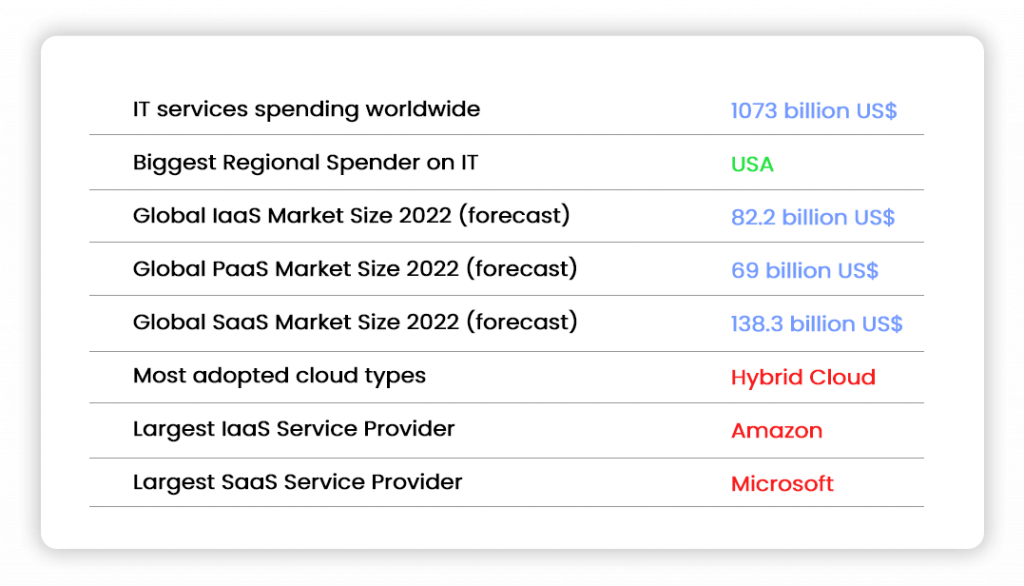
25 Feb Is your business on par with top trends in cloud computing?
It is 2021, and businesses are steering their operations as COVID-19 and its mutants continue to wreak havoc. The year 2020 put the entire world topsy-turvy, and the global market fell headlong. Businesses were forced to adjust to the new normal, with homes doubling up as workstations worldwide.
In this context, some of the biggest business concerns that arose were:
- “How can organizations protect their critical data in a completely disrupted work environment?”
- “What can companies do to protect their critical data?”
- “How can enterprises get on with Business Continuity Plans (BCP) and Business as Usual (BAU)?”
All questions led to one answer – ‘Cloud Computing.’
What is Cloud Computing?
Cloud computing enables access to:
- Application: Monitoring, content, collaboration, communication and, finance
- Platform: Object storage, identity, runtime, queue and, database
- Infrastructure: Computer, block storage and, networks
…for storing, managing, and processing data. Businesses can leverage cloud services for uninterrupted operations and capabilities that enhance business potential and possibilities. Today, it’s beyond doubt that cloud has become a business necessity.
So, what are the advantages of cloud computing?
Cloud has many advantages like cost reduction, data security, scalability, data control, data recovery and it has a competitive edge to it. Cloud can store large chunks of data. Data processing is done through the Internet and there is no hard drive or physical spaces needed for storing data.
Furthermore, cloud experts believe that the cloud security market will see demand soaring owing to the need for solving the hybrid multi-cloud intricacies– one more reason to say “Yes” to the cloud!
What are the latest cloud computing trends?
Even though the aftermaths of COVID-19 will linger throughout 2021, through increased agility businesses can lay a solid foundation for the future of the cloud. 2021 will see an acceleration in cloud computing’s future trends. And while it’s good for organizations to have many digital transformation plans, it is imperative to align them with scalable cloud models.
Companies’ current trend in cloud computing is the utilization of PaaS platform that will support the forced circumstances of remote workstations.

The future of cloud computing!
Globally, the public cloud infrastructure will be worth $120 billion. Cloud computing has always benefited data organization and data processing. The cloud-centric software development and on-premises computes will supply hybrid IT solutions which makes an important step in the future of cloud computing.
Following are the cloud computing trends expected to happen in 2021:
- Cloud strategies will be shifted to Edge through 5G andAI,thereby becoming more connected
- Companies invested AI projects will partner with cloud offerings forstrengtheningtheir AI engineering strategies
- Clouds will be linked for joint customer migration and managing enterprise application works
- Server-less cloud computing for application designing and development
- Managing interconnected services across applications through automated cloud computing
- Secure Access Service Edge (SASE) for combining WAN capabilities with cloud network security services
- Embedding cloud migration and data privacy in the business process for building new systems
- Improving operational efficiency through enhanced cloud infrastructure at controlled costs
Together with these trends, cloud computing there will be a paradigm shift in the following aspects:

Storage Capacity
Data is available in plenty and the safeguarding stored data is a challenging task for organizations. To tackle the situation, businesses are looking to cloud computing. To their advantage, cloud service providers will be providing more data centers at low prices owing to the tough competition among the players in the market.
Internet Performance Boosting
How can internet performance be improved? IoT can sufficiently ensure the quality of the internet. With IoT incorporated cloud computing, data can be secured in the cloud. When IoT devices generate large amount of data through the internet, cloud computing makes it easier for storing, scaling and speedily accessing these data.
Different Cloud Service Servers
The future of software development will be modular and there will be many places where different modules of the software are stored and there will be different cloud service providers for each module. System thinking is already an industry trend in cloud computing. So, when the components in a system is placed in a different setting, it will act differently. System thinking will integrate these components functioning from different cloud servers solving any likely complex conditions.
IoT in Cloud Computing
Cloud computing has a lot of data to deal with and the rise of IoT has seen a boom in machine communications. Leveraging cloud computing, users can apply innovative approaches to process real-time data with IoT and Data Analytics.
Cloud Service Upgrading
One of the biggest advantages of cloud computing is that it is compatible with any organization irrespective of its size or any other factors. It is presumed that more than 60% of the workload will be accounted for through Software as a Service (SaaS). Again, there is Platform as a Service (PaaS) and Infrastructure as a Service (IaaS) undergoing continuous innovation to meet organizational needs.
Some Interesting 2021 Statistics of Cloud Computing Trends!

Conclusion
Cloud computing offers many benefits like cost reduction, low maintenance and less upgrades, thus enabling businesses to focus on their mainstream activities. However, one of the biggest drawbacks of cloud computing is the inability to provide 100% protection of data saved in cloud. Once regulations and standardization of data security is made stringent, the future of cloud computing is going to be aspiring!
